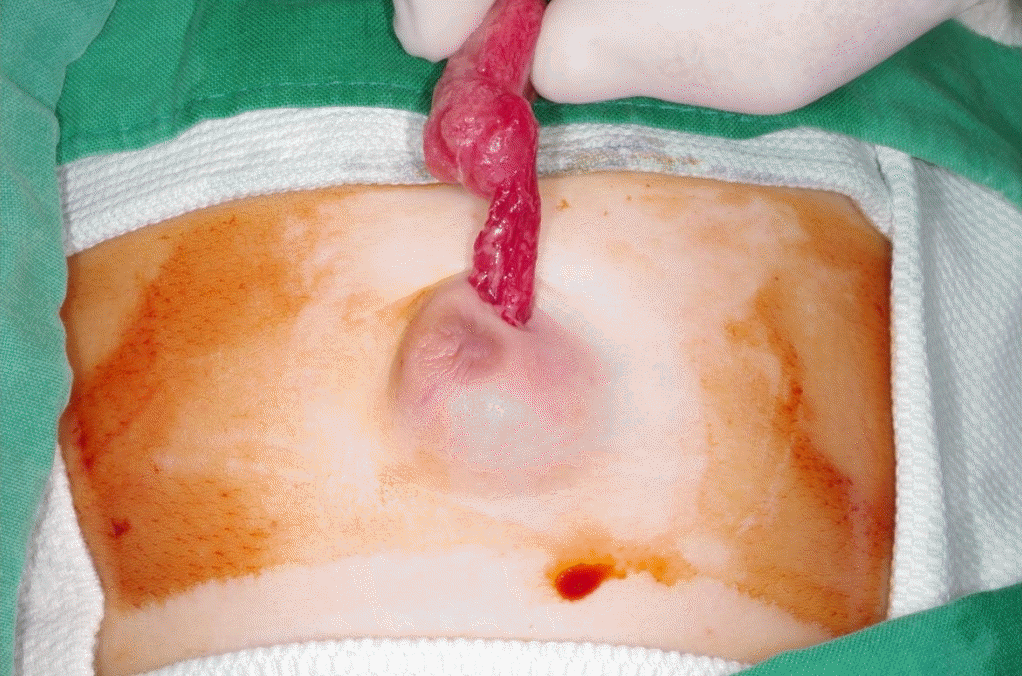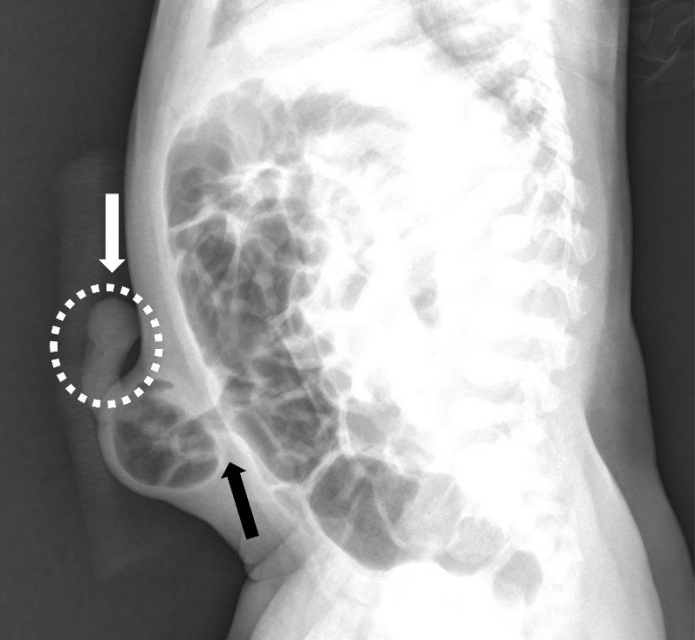Abstract
Serious acupuncture-related complications are rare in infants. We experienced a case of a 58-day-old infant with an umbilical hernia who received acupuncture from a non-professional guardian. Upon initial examination in the emergency department, the omentum protruded through the skin defect caused by acupuncture performed on top of the hernia. The infant underwent emergency surgery, and subsequently recovered uneventfully.
Go to : 
Acupuncture is a widely used, alternative therapy in East Asia, and its use has spread to Europe and America1). Acupuncture-related complications are infrequent if the procedure is performed by skilled professionals2,3). In Korea, acupuncture is usually done by non-professionals as a folk remedy to treat vague digestive symptoms. Although resin or blood needles are considered safe for use by non-professionals, the needles have been seldom used in infants. Herein, we describe an infant case of umbilical hernia where emergency surgery was performed to treat omental evisceration, which occurred due to an acupuncture performed by a non-professional guardian using blood needles. This study was approved by the institutional review board of Keimyung University Dongsan Hospital (IRB no. 2023-04-043).
Go to : 
A 58-day-old infant boy presented to the emergency department with an eviscerated internal organ located near the umbilicus. The boy had presented with a reducible umbilical hernia since birth, and 1 day prior to the visit to us, had undergone acupuncture for the hernia. The acupuncture was performed for unknown number of times and depth, by his grandmother who was unauthorized for the procedure. After the acupuncture, he started to cry irritably, and small reddish tissue started protruding through the puncture site, left superior side of the umbilicus (Fig. 1). Subsequently, more tissue protruded with the color changing to blue. No gastrointestinal symptoms, such as projectile vomiting, were reported. He had been delivered healthy and was generally active. The initial vital signs were as follows: heart rate, 189 beats/minute; respiratory rate, 36 breaths/minute; temperature, 36.5°C; and oxygen saturation, 100% on room air. Initial laboratory findings were generally within normal limits, except the white blood cell count of 16,690/µL. Plain radiography showed an umbilical hernia with the protruded omentum (Fig. 2). After intravenous hydration and administration of cefazolin, emergency surgery was performed on day 1. The protruded omentum was resected, and the umbilical hernia was repaired via an infra-umbilical incision. The infant recovered well, and was discharged without complications on day 4.
Go to : 
An umbilical hernia is a defect of the abdominal wall around the umbilicus4). A hole is created in the umbilical cord, and after birth, it is closed by the abdominal muscles. However, if it does not close properly, passage of the fat or bowel through the defect may induce palpable bulging and pain4). The skin stretches thin at the protruding part of umbilical herniation, and the bowel or omentum lies beneath the skin4). Umbilical hernia typically resolves spontaneously by 5 years of age whereas it is usually repaired surgically in children older than 5 years4,5). The hernia needs surgery when complications, such as incarceration, strangulation or rupture, develop4). Surgical complications, such as infection, hematoma, and seroma, can rarely occur.6) Postoperative recurrence is known to occur in about 2%.6)
This case highlights that acupuncture can convert umbilical hernia, which does not need emergency surgery, into iatrogenic evisceration, a surgical emergency. This risk is feasible because the stretched skin overlying the umbilical hernia may be easily penetrated by acupuncture, particularly if performed by non-professionals. Through a defect causing evisceration, the absence of skin barrier, the skin flora can invade the peritoneal cavity, leading to incarceration and necrosis7).
The adverse effects of acupuncture are influenced by various factors. The primary factor is the degree of training of acupuncturists; experience in acupuncture could influence the risk of complications8). Acupuncture is usually performed at depths of 6.4-38.1 mm, with 4-20 needles with diameters of 0.1-0.3 mm and lengths of 12.7-76.2 mm9), and protocols of specific needle use vary across individual acupuncturists and institutions9). Thickness of the infant skin is about 2 mm, which may predispose to an internal organ injury on any acupuncture10).
The complications of acupuncture treatment show mostly minor manifestations, such as local pain at the puncture site, bleeding, bruising, and skin lesions11). Rare but serious complications include internal organ injury, infections, subarachnoid hemorrhage, infective endocarditis, and cardiac tamponade12-14). There have been few reports of serious complications after acupuncture in children15). To our best knowledge, only 1 similar case was reported in a 2-year-old boy who developed hematoma and bowel obstruction after acupuncture14). We could not find reports of umbilical hernia accompanied by evisceration other than this present case.
In conclusion, acupuncture (blood needles)-induced rupture of umbilical hernia complicated with evisceration is a rare but serious, iatrogenic complication requiring immediate emergency surgery.
Go to : 
References
1. Zhuang Y, Xing JJ, Li J, Zeng BY, Liang FR. History of acupuncture research. Int Rev Neurobiol. 2013; 111:1–23.

2. Chan MWC, Wu XY, Wu JCY, Wong SYS, Chung VCH. Safety of acupuncture: overview of systematic reviews. Sci Rep. 2017; 7:3369.

3. Bäumler P, Zhang W, Stübinger T, Irnich D. Acupuncture-related adverse events: systematic review and meta-analyses of prospective clinical studies. BMJ Open. 2021; 11:e045961.

5. Burcharth J, Pedersen MS, Pommergaard HC, Bisgaard T, Pedersen CB, Rosenberg J. The prevalence of umbilical and epigastric hernia repair: a nationwide epidemiologic study. Hernia. 2015; 19:815–9.

6. Zendejas B, Kuchena A, Onkendi EO, Lohse CM, Moir CR, Ishitani MB, et al. Fifty-three-year experience with pediatric umbilical hernia repairs. J Pediatr Surg. 2011; 46:2151–6.

7. Ogu US, Valko J, Wilhelm J, Dy V. Spontaneous evisceration of bowel through an umbilical hernia in a patient with refractory ascites. J Surg Case Rep. 2013; 2013:rjt073.

8. Leung PC, Zhang L, Cheng KF. Acupuncture: Complications are preventable not adverse events. Chin J Integr Med. 2009; 15:229–32.

9. Berman BM, Langevin HM, Witt CM, Dubner R. Acupuncture for chronic low back pain. N Engl J Med. 2010; 363:454–61.

10. Ofri A, Schindler T, Dilley A, Pereira J, Adams S. Defining normal neonatal abdominal wall musculature with ultrasonography. J Pediatr Surg. 2018; 53:1588–91.

12. AlFraih Y, Merali HS. Pneumothorax secondary to acupuncture in an adolescent girl. Pediatr Emerg Med J. 2021; 8:35–7.

13. Kim TH, So JS. Deleterious consequence of acupuncture: case report of acute cervical epidural hematoma. J Korean Soc Emerg Med. 2022; 33:416–20.
Go to : 




 PDF
PDF Citation
Citation Print
Print





 XML Download
XML Download